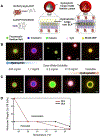Genetically Fusing Order-Promoting and Thermoresponsive Building Blocks to Design Hybrid Biomaterials
- PMID: 38501912
- PMCID: PMC11661552
- DOI: 10.1002/chem.202400582
Genetically Fusing Order-Promoting and Thermoresponsive Building Blocks to Design Hybrid Biomaterials
Abstract
The unique biophysical and biochemical properties of intrinsically disordered proteins (IDPs) and their recombinant derivatives, intrinsically disordered protein polymers (IDPPs) offer opportunities for producing multistimuli-responsive materials; their sequence-encoded disorder and tendency for phase separation facilitate the development of multifunctional materials. This review highlights the strategies for enhancing the structural diversity of elastin-like polypeptides (ELPs) and resilin-like polypeptides (RLPs), and their self-assembled structures via genetic fusion to ordered motifs such as helical or beta sheet domains. In particular, this review describes approaches that harness the synergistic interplay between order-promoting and thermoresponsive building blocks to design hybrid biomaterials, resulting in well-structured, stimuli-responsive supramolecular materials ordered on the nanoscale.
Keywords: disordered proteins; peptides; phase transitions; self-assembly; supramolecular assembly.
© 2024 Wiley-VCH GmbH.
Conflict of interest statement
Conflict of Interests
The authors declare no conflict of interest. Sai S. Patkar is currently an employee and common stock owner of Eli Lilly and Company. The work presented herein was completed prior to her employment with Eli Lilly and Company. Sai Patkar is acting entirely on her own and any opinions or endeavors expressed herein are not in any manner affiliated with Eli Lilly and Company.
Figures










Similar articles
-
Application of Thermoresponsive Intrinsically Disordered Protein Polymers in Nanostructured and Microstructured Materials.Macromol Biosci. 2021 Sep;21(9):e2100129. doi: 10.1002/mabi.202100129. Epub 2021 Jun 18. Macromol Biosci. 2021. PMID: 34145967 Free PMC article. Review.
-
Elastin-like polypeptides as models of intrinsically disordered proteins.FEBS Lett. 2015 Sep 14;589(19 Pt A):2477-86. doi: 10.1016/j.febslet.2015.08.029. Epub 2015 Aug 29. FEBS Lett. 2015. PMID: 26325592 Free PMC article. Review.
-
Self-assembling systems comprising intrinsically disordered protein polymers like elastin-like recombinamers.J Pept Sci. 2022 Jan;28(1):e3362. doi: 10.1002/psc.3362. Epub 2021 Sep 20. J Pept Sci. 2022. PMID: 34545666 Review.
-
Lipidation Alters the Structure and Hydration of Myristoylated Intrinsically Disordered Proteins.Biomacromolecules. 2023 Mar 13;24(3):1244-1257. doi: 10.1021/acs.biomac.2c01309. Epub 2023 Feb 9. Biomacromolecules. 2023. PMID: 36757021 Free PMC article.
-
Programmability and biomedical utility of intrinsically-disordered protein polymers.Adv Drug Deliv Rev. 2024 Sep;212:115418. doi: 10.1016/j.addr.2024.115418. Epub 2024 Jul 31. Adv Drug Deliv Rev. 2024. PMID: 39094909 Review.
Cited by
-
Recombinant fibrous protein biomaterials meet skin tissue engineering.Front Bioeng Biotechnol. 2024 Aug 14;12:1411550. doi: 10.3389/fbioe.2024.1411550. eCollection 2024. Front Bioeng Biotechnol. 2024. PMID: 39205856 Free PMC article. Review.
-
Toward understanding biomolecular materials comprising intrinsically disordered proteins via simulation and experiment.Mol Syst Des Eng. 2025 Apr 25;10(7):502-518. doi: 10.1039/d4me00197d. eCollection 2025 Jun 30. Mol Syst Des Eng. 2025. PMID: 40386766 Free PMC article. Review.
-
Spontaneous Self-Organized Order Emerging From Intrinsically Disordered Protein Polymers.Wiley Interdiscip Rev Nanomed Nanobiotechnol. 2025 Jan-Feb;17(1):e70003. doi: 10.1002/wnan.70003. Wiley Interdiscip Rev Nanomed Nanobiotechnol. 2025. PMID: 39950263 Free PMC article. Review.
References
Publication types
MeSH terms
Substances
Grants and funding
- GM103446/GF/NIH HHS/United States
- 2125703/NSF NRT MIDAS
- 1609544/Division of Materials Research
- DC011377/GF/NIH HHS/United States
- 2004890/Division of Materials Research
- P20 GM104316/GM/NIGMS NIH HHS/United States
- 2004796/Division of Materials Research
- 0239744/Division of Materials Research
- P20GM104316/GF/NIH HHS/United States
- GM139760/GF/NIH HHS/United States
- P20 RR017716/GF/NIH HHS/United States
- P20 GM103446/GM/NIGMS NIH HHS/United States
- P20 RR017716/RR/NCRR NIH HHS/United States
- P20 GM139760/GM/NIGMS NIH HHS/United States
- 2011824/Division of Materials Research
- R01 DC011377/DC/NIDCD NIH HHS/United States
LinkOut - more resources
Full Text Sources

